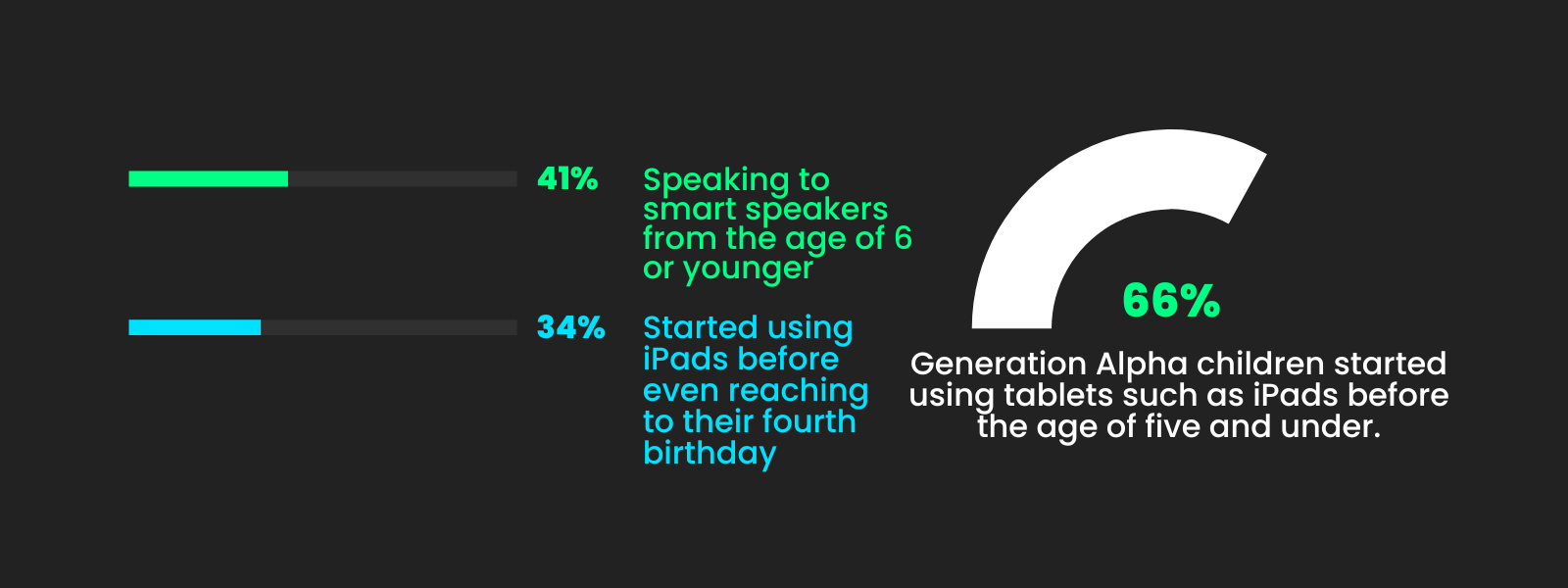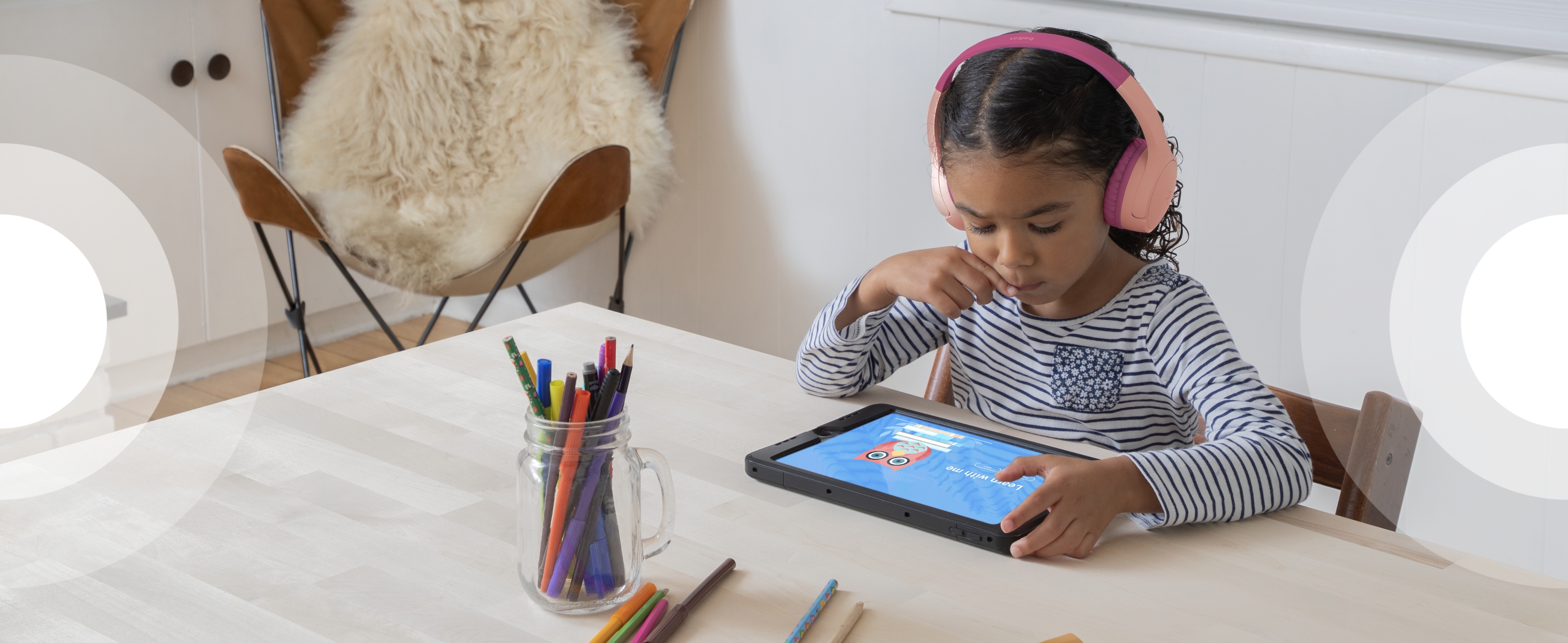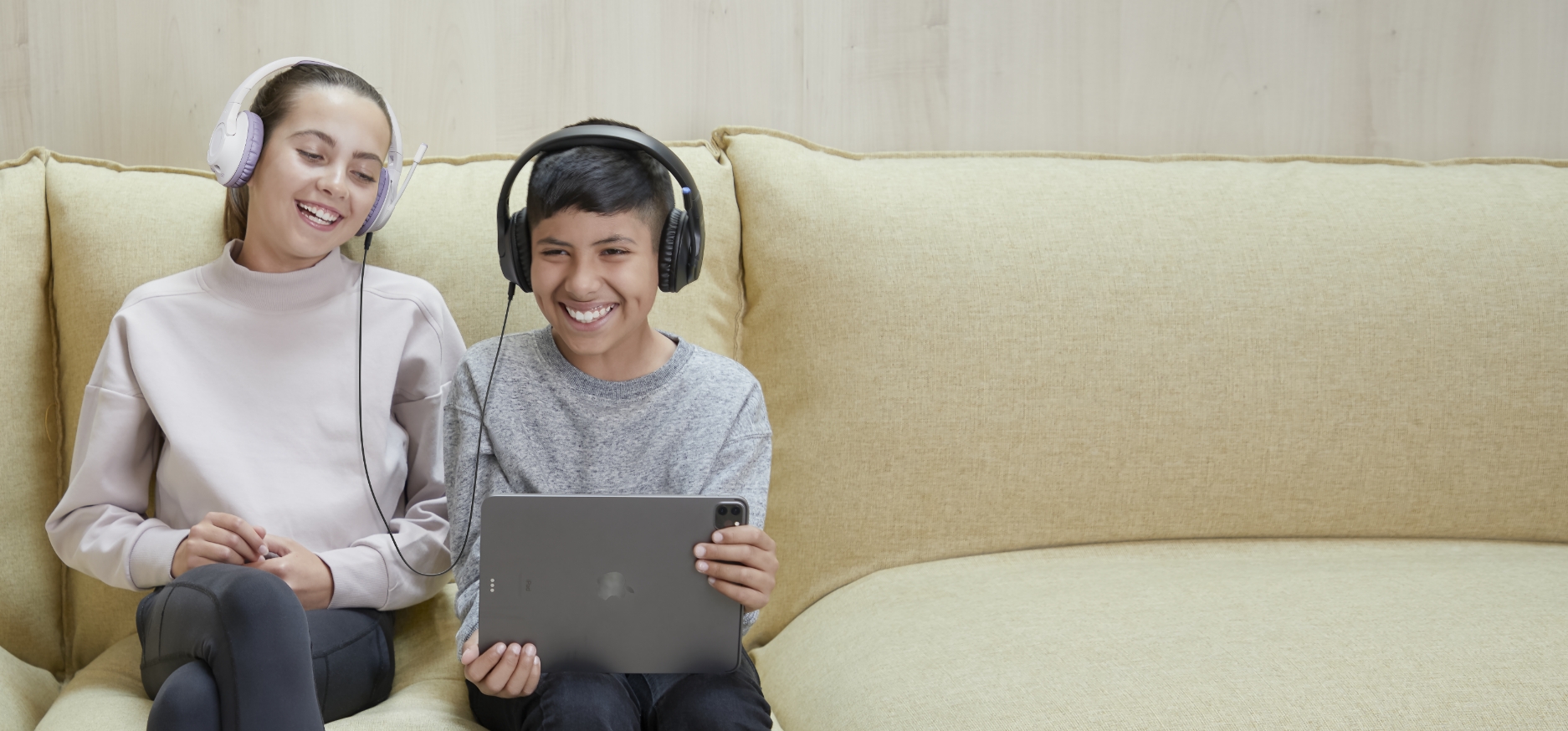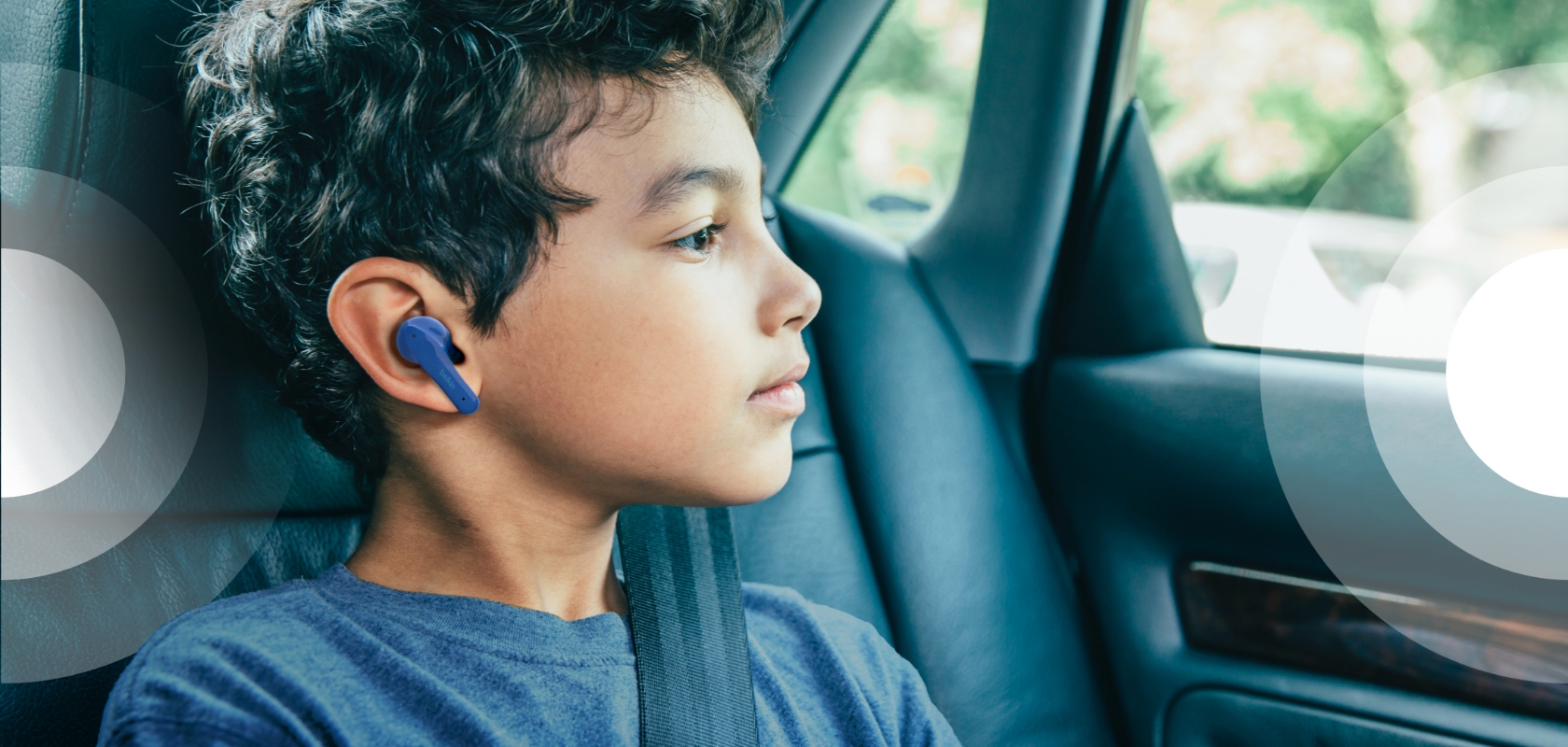How to choose safe earbuds & headphones for your kids – a must-know guide for every parent.
November 29, 2023
Generation Alpha (born 2010 to today) is the first generation to grow up in a fully digital world. Fully immersed in technology since birth, smartphones, tablets, and other electronic devices are staples in their everyday experience.
According to research, two-thirds (66%) of Generation Alpha children started using tablets such as iPads before the age of five and under. Two-fifths (41%) say they have been speaking to smart speakers from the age of 6 or younger, and, incredibly, a third (34%) claim to have first started using iPads before even reaching their fourth birthday.
With Gen Alpha’s use of technology being as intrinsic as interaction with family members, the right choice of peripheral accessories is imperative to keep young users safe for years to come.

Why do you want headphones & earbuds designed for kids?
When it comes to products made for kids, safety, quality, and ease of use are essential considerations.
Volume.
Gen Alpha is digitally native, but this doesn’t make the technology available to them intrinsically safe – permanent Noise-Induced Hearing Loss (NIHL) is an important consideration. According to the UK Hearing Conservation Association, you are born with around 15,000 auditory hair cells. The number you are born with is all you’ll ever have. Once they’re damaged, they don’t transmit sounds to the brain, meaning the damage is permanent and lifelong.
Noise-Induced Hearing Loss is caused by ongoing, loud sound exposure which damages the hair cells, and shows up slowly – it’s a cumulative build-up of sudden changes over time. Playing audio beyond safe limits in earbuds/headphones can contribute to this – without a limit in place, children may not be aware of how loud “too loud” is – and regular usage at unsafe levels can cause damage over time, leading to eventual NIHL, as well as having a negative effect on their development.
Quality.
Delicate products need not apply. Kids and young adults need their audio products to withstand a tumble or two. Whether they’re haphazardly tossed in a bag while on the go, jumbled up amongst a plethora of toys, or handled by a few sticky fingers, their audio products need to keep up with all of life’s adventures.
Fun fact: when it comes to the kid’s audio range by Belkin, it has been tested to function after spilling 4 ounces of water onto the product (then dried). Additionally, it has also been tested to function after a 2-meter drop onto a hard surface.
Design.
When it comes to design, it’s essential that audio products don’t just look good, but are made specially for the ears of those wearing them. The in-ear buds on SoundForm Nano feature a wide range of ear tip sizes (XXS-L) for the perfect fit.
When it comes to over-ear headsets, Belkin’s in-house engineering team specially designed the SoundForm Mini and SoundForm Inspire to fit securely over a child’s head. With precision and attention to detail in mind, parents can rest assured that they are not simply a smaller version of an adult headset.
TOP 5 FEATURES to look for when selecting audio products for your child
*Why Belkin headphones for kids are trusted by 1M+ kids and parents
1. Frequency response and volume limitation.
Frequency response is essential when it comes to audio. Good response essentially means what you’re listening to sounds good, so the need to increase the volume is reduced. When good frequency response is present, the audio device can express low, middle, and high tones exactly as they should sound while maintaining even distribution. The audio product will therefore pick up and express the sound as it was intended, so there is no need to overcompensate by fiddling with the volume to hear voices over instrumentals.
This is where Belkin Signature Sound shines. Integrated throughout the SoundForm collection, this technology was developed within the in-house audio labs at Belkin headquarters in Los Angeles, California. Belkin Signature Sound reveals the subtlest details by balancing deep bass to crystal-clear vocals to crisp treble, precision- engineered to reproduce a rich, immersive home theatre sound with excellent frequency response to reduce the need to turn up the volume.
Additionally, all SoundForm kids' audio products come with a built in 85dB volume limiter. This is the maximum volume level recommended by the World Health Organization (WHO) as safe for ongoing listening. Most adult headphones reach much higher volume levels, so using audio products without this safety feature can be dangerous for young ears.
2. A comfortable fit and long battery life.
When it comes to in-ear audio, the the use of high-quality materials plus testing with real kids means a comfortable fit inside the ear SoundForm Nano or around the ear SoundForm Mini and SoundForm Inspire. With the correct shape, a good seal is also formed between the audio device and ear canal, which can help block out ambient noise for even better listening. Long battery life keeps kids connected and on the go for longer.
3. A great fit + long battery life = great comfort and nonstop sound:
- SoundForm Nano – Ear tips from size XXS to L are included to make sure your child finds the best match. This product was tested with kids around the world between the ages of 7 and 14 years old to ensure optimal fit and comfort. 5 hours of playtime and another 19 hours of charge in the case.
- SoundForm Mini – Designed as an 'on ear' product to work optimally with the smaller shape of children’s heads from ages 3 and up. 28-30 hours battery life for nonstop listening.
- SoundForm Inspire – An over ear headset also tested amongst kids worldwide between ages 5 and 14 to ensure comfortable over ear coverage. Fast USB-C charging brings up to 35 hours of playtime on a full charge.
4. Using a trusted brand matters.
Since 1983, Belkin has created high quality products to connect people with their technology, whether at home, at work or on a new adventure. The Belkin SoundForm collection delivers audio solutions packed with features to enable users of all ages to connect safely and seamlessly throughout their day and get the most out of every connection. On a journey to build products more responsibly, Belkin made a public commitment to transition both existing and new products to post-consumer recycled plastic (PCR) and plastic free packaging, which began early 2023.
5. How to choose the best headphones or earbuds for your child?
Technology provides opportunity for fun, but also ways to learn and connect. Some common uses for headphones and earbuds for children include:
Learning
Education has naturally evolved to meet students and the wider world where it stands. Technology is frequently found in today’s classrooms and is used by teachers to make their teaching more creative, innovative, engaging, and enjoyable. As it stands, in 2023, 84% of American students are using technology in the classroom. 60% of American students have a school-provided device, and an additional 14% bring their own devices from home.
Try:
- SoundForm Inspire – Listen solo or with a classmate. RockStar Mode allows kids to connect a set of wired headphones to the 3.5mm output and listen to together.
- SoundForm Mini – Developed with real kids in mind, Mini makes the perfect study buddy. Tested for compatibility with programs like Zoom, Schoology, and more, the Mini goes a mile when it comes to serious study.

Connecting to friends and family
Gone are the days when personal connection could only happen via phone, e-mail or snail mail. Video calling has become the norm, and 79% of Millennial parents say their children are social media users of one platform or another. Social media and gaming are new ways to socialize, creating a way of interacting with peers not utilized by previous generations. In the United States, the number of children between eight and 11 years owning a smartphone has increased from approximately 10 percent in 2015 to 31 percent in 2021.
Try:
- SoundForm Inspire – When spoken by a loved one, every word is important. Belkin’s design and engineering teams kept this in mind when integrating Inspire’s boom mic with clear call technology to ensure not a single word is missed. When something needs to be communicated discreetly, the boom mic can be flipped up to mute, as well as by pressing a mute button, and an LED indicator also signals the mute is on.

On the road
Powerful, portable technology like tablets, phones and dedicated gaming devices make accessing content while on the go easier than ever. This generation of “Screenagers” marks those born from 2010 – the same year the first iPad was released. In 2022, a study found that children aged 8 to 12 years now spend 5-and-a-half hours per day on screen media, compared to an average of 4 hours 44 minutes per day in 2019. More portable than ever, screen-based products are frequently used to entertain not just in the home, but out of the home too.
Try:
- SoundForm Inspire – Rockstar Mode helps share the joy of a favourite film, show or song. Daisy chain with a sibling or friend to listen and watch the same screen in unison and enjoy a family favourite together.
- SoundForm Nano – Small, great battery life and ready to roam. Nano makes a great in-ear audio companion to always keep by your child’s side.

FAQ
Which headphone is good for kids?
When it comes to selecting the right headphone for your child, durability, frequency response/volume, and durability play important factors. The product should be able to withstand daily wear and tear, be specially designed to fit young ears and offer good quality sound that prevents the need to turn up the volume to hear clearly, along with a safe volume limit.
What age should kids use headphones?
Headphones for kids can be used from age 3. As with all technology items designed for children, parents should always keep a close eye and ensure children are using products responsibly.
What type of headphones do kids need for school?
With classrooms integrating technology more and more, headphones that feature benefits like daisy chaining (allowing two people to listen when sharing one screen. I.e. Inspire’s “Rockstar Mode”) turns a solo study session into a collaborative experience. Compatibility testing for programs frequently used in educational settings like Zoom and Schoology ensure the audio product works for whatever the school day has in store. Comfort is also important in the classroom – headphones should be comfortable to wear for long stretches of time.
What is a safe headphone level for kids?
To reduce NIHL, volume levels for young ears need to be kept at a suitable level. The recommended volume limit for kids is 85dB. However, there are further elements within sound technology that go beyond volume limiting to encourage volume levels to start low and stay there. Frequency response is essential when it comes to audio – Good response means what you’re listening to sounds clear even at a low volume therefore, the need to increase the volume is reduced.
Are earbuds bad for children's ears?
With responsible usage, earbuds developed specially for young ears are a great way to utilise all the benefits of wireless audio products when on the go. Not to mention, they can resemble adult versions of the same product, just with all the added safety features. This helps kids of all ages stay safe while keeping up with their peers and more mature family members at the same time.
Are earbuds or headphones better for kids?
The decision should be based on the age and preference/needs of the wearer. Headphones tend to be more suitable for younger kids (3-9) whereas slightly older kids can choose between earbuds and headphones.
We hope you enjoyed this post. Signup for blog alerts, product announcements, and exclusive deals via emails and texts now.

